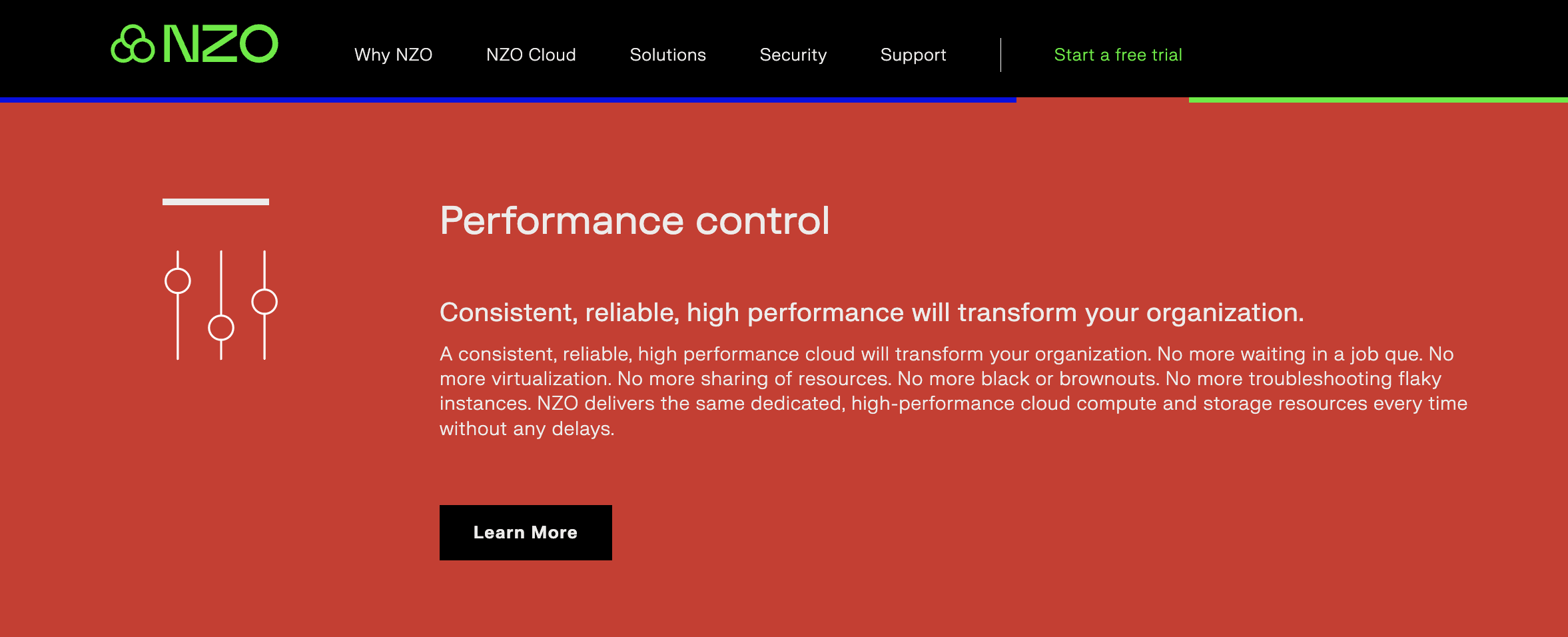Table of Contents

More and more businesses from all industries are moving their operations to the cloud. This is because cloud computing has come a long way in recent years, and it’s now possible to take full advantage of high-performance computing in the cloud to host applications without needing to invest in expensive on-premise hardware. However, proper cloud performance management is essential to ensure this transition is successful.
Most businesses fail to plan for cost and performance when migrating critical applications to the cloud. They expect, understandably, that costs will decrease and the overall performance of the applications in question will increase. However, this isn’t always the case.
Simply migrating these applications to the cloud and calling it a day is not enough. You must consider the workflow of how your employees and/or customers use these applications and implement a clear plan to ensure that these applications run as expected when they are used.
For example, a small midwestern bank in the United States moved their business-critical applications to the cloud without considering cloud performance management. Afterward, customers and employees reported that using these apps actually took longer than it did before when they were on on-premise systems and that productivity was being affected. So what happened? The IT team at the bank didn’t realize that simply migrating their important applications to the cloud without a prior cloud performance review plan could result in worse outcomes than their previous solution. Even though the cloud gave the organization more computing power and storage, performance was hindered.
Understanding all the moving parts involved in ensuring a good experience is crucial. In the case of the bank, understanding when to get agents involved, being able to anticipate certain patterns of responses from users, and being able to predict and plan for new workflow interruptions were not considered, and it resulted in poor performance.
Cloud based performance management software plays a crucial role in ensuring optimal cloud computing design, scalability, and availability of cloud services. In this article, we will explore the various factors that contribute to the success of cloud performance management.
What is Cloud Performance Management?
Before diving into the success factors, let’s first understand what Cloud Performance Management entails. Cloud performance management is the process of monitoring, analyzing, and optimizing the performance of applications and infrastructure in a cloud environment. It involves tracking key performance indicators, identifying bottlenecks, and implementing measures to improve overall performance and user experience.
- One key aspect of cloud based performance management software is the utilization of monitoring tools that provide real-time insights into the health and performance of cloud-based systems. These tools help organizations proactively identify issues such as latency spikes, resource constraints, or configuration errors that could impact the performance of critical business applications. By leveraging these tools, businesses can ensure that their cloud environments operate at peak efficiency and deliver optimal performance to end-users.
- Cloud performance management also encompasses capacity planning, which involves forecasting future resource needs based on historical data and expected growth. This proactive approach allows organizations to scale their cloud resources accordingly, ensuring they can meet the demands of increasing workloads without experiencing performance degradation. By effectively managing capacity, businesses can avoid costly downtime and maintain a seamless user experience even during periods of high demand.
Cloud Application Performance Management (Cloud APM)
Cloud APM, also known as cloud application performance management, is a subset of cloud performance management that focuses specifically on monitoring and managing the performance of cloud-based applications. It involves collecting and analyzing metrics such as response time, throughput, and error rates to identify performance issues and take necessary actions to optimize application performance.
- Monitoring: Cloud APM tools continuously monitor various aspects of application performance, including response times, resource utilization, error rates, and network latency. Real-time monitoring alerts stakeholders to performance issues, enabling proactive troubleshooting and resolution.
- Diagnostics: When performance issues occur, Cloud APM tools provide diagnostic capabilities to identify the root cause quickly. Detailed insights into application code, dependencies, and infrastructure components help pinpoint performance bottlenecks and inefficiencies.
- Optimization: Cloud APM solutions offer optimization features to enhance application performance and efficiency. This may include auto-scaling resources based on demand, optimizing database queries, or fine-tuning configuration settings for optimal performance.
- User experience management: Cloud APM tools also focus on monitoring and improving the end-user experience. By tracking user interactions, session duration, and user journey paths, businesses gain insights into how users interact with their applications and can make improvements to enhance usability and satisfaction.
- Reporting and analytics: Cloud APM solutions provide robust reporting and analytics capabilities to track performance trends over time, identify patterns, and measure the impact of optimization efforts. These insights enable data-driven decision-making and continuous improvement of application performance.
Aspects of Cloud Performance Management
Cloud performance management software encompasses various aspects that are essential for ensuring optimal performance. By effectively managing these aspects, organizations can achieve better performance, scalability, and cost efficiency in the cloud.
The table below outlines some of the key aspects of cloud performance management software:
| Key Aspect of Cloud Performance Management | What it Does |
| Real-time cloud performance monitoring | Provides real-time insights into the performance of applications running in the cloud. This real-time monitoring allows organizations to quickly detect and address performance issues before they impact end-users. By leveraging advanced analytics and machine learning algorithms, Cloud APM tools can proactively identify trends and patterns that may indicate potential performance bottlenecks. |
| Cloud application management | Focuses on optimizing the performance and availability of cloud-native and third-party applications. It involves monitoring application performance metrics, identifying performance bottlenecks, and implementing optimization strategies. Cloud application management encompasses various aspects, including load balancing, auto-scaling, caching, and database optimization. By fine-tuning application performance, organizations can deliver superior user experiences, enhance productivity, and drive business growth. |
| Intelligent infrastructure resourcing | Automatically adjusts resources based on application demand to ensure optimal performance and cost-efficiency. This dynamic scalability is particularly beneficial for cloud-based applications with fluctuating workloads, as it helps maintain consistent performance levels without overspending on unnecessary resources. |
| Cloud migration | Plays a pivotal role in modernizing IT infrastructure and unlocking agility and scalability. However, migrating workloads to the cloud requires careful planning and execution to ensure a seamless transition. Effective cloud migration strategies involve assessing existing infrastructure, identifying suitable cloud environments, and prioritizing workloads for migration. During the migration process, organizations must address compatibility issues, data security concerns, and performance implications to minimize disruption and maximize the benefits of cloud adoption. |
| Security monitoring | Ensuring the security of cloud environments is paramount to maintaining optimal performance. Continuous monitoring for security threats, vulnerabilities, and compliance issues is crucial for safeguarding sensitive data and maintaining the trust of customers. |
| Cost optimization | Managing costs in the cloud involves analyzing usage patterns, optimizing resource allocation, and implementing cost-saving measures such as reserved instances or spot instances. By effectively managing costs, organizations can maximize their return on investment and ensure long-term financial sustainability in the cloud. |
Cloud APM vs. Application Performance Monitoring

While cloud APM focuses on monitoring cloud-based applications, application performance monitoring (APM) is a broader concept that encompasses monitoring the performance of applications across various environments, including traditional on-premises setups. However, with the increasing adoption of cloud-based architectures, cloud APM has gained prominence in recent years.
The table below compares these two options at a high level:
| Cloud APM | Application Performance Monitoring | |
| Definition | Focuses on monitoring the performance of applications deployed in the cloud | Concentrates on monitoring the performance of individual applications within an IT infrastructure |
| Deployment | Tailored for cloud-based applications and services | Can be deployed in various environments, including on-premises, cloud, and hybrid environments |
| Scope | Monitors the overall health and performance of cloud-native applications and services running on various cloud platforms | Provides detailed insights into the performance of specific applications, including metrics on transactions, response times, errors, and resource utilization |
| Scalability | Scales dynamically to accommodate changes in cloud resources and workloads | Offers scalability to handle fluctuations in workload and user demand |
| Integration with cloud services | Offers seamless integration with cloud-native tools and platforms | Integrates with cloud services and platforms, providing visibility into cloud-based applications |
| Automation | Employs automation for performance-monitoring tasks | Utilizes automation to detect anomalies and optimize application performance |
| Cost | Typically follows a subscription-based pricing model, with costs based on usage and features | May involve subscription-based models or licensing fees depending on the APM solution |
Overall, cloud APM provides specific capabilities tailored to the unique challenges of monitoring applications in a modern cloud environment, such as dynamic scalability, distributed architectures, and varying infrastructure configurations.
One of the key advantages of cloud APM is its ability to provide real-time insights into the performance of cloud-based applications. By leveraging advanced monitoring tools and techniques, cloud APM solutions can track and analyze key performance metrics, such as:
- Response times
- Error rates
- Resource utilization
All across distributed cloud environments. cloud APM also offers enhanced visibility into the dependencies and interactions between different components of a cloud application. This holistic view allows organizations to identify performance bottlenecks, optimize resource allocation, and improve the overall user experience.
Success Factors with Cloud Performance Management

Successful implementation of cloud performance management requires considering multiple factors:
1. Proactive Monitoring and Alerting
Proactive monitoring and alerting are fundamental to effective cloud performance management. By continuously monitoring cloud resources and applications, organizations can identify performance issues and potential bottlenecks before they impact operations. Automated alerting mechanisms notify stakeholders of anomalies or deviations from predefined thresholds, enabling prompt action to resolve issues and minimize downtime.
Various tools are available to assist with proactive surveillance, including:
- System alerts
- Event logs
- Performance metrics
With the information from these tools, it’s easier for IT teams to recognize anomalies as well as patterns and trends that might lead to an issue later down the road, and prepare for these issues accordingly.
2. Comprehensive Performance Metrics
Comprehensive performance metrics provide valuable insights into the health and performance of cloud infrastructure and applications. Organizations should track a wide range of metrics, including resource utilization, response times, throughput, error rates, and user experience metrics.
Data-driven decision-making involves leveraging performance metrics, analytics, and insights to inform strategic decisions related to cloud performance management. By collecting, analyzing, and interpreting data from various sources, organizations can identify patterns, trends, and correlations that impact performance. Data-driven insights enable organizations to prioritize optimization efforts, allocate resources effectively, and address performance issues based on empirical evidence rather than assumptions. By adopting a data-driven approach, businesses can optimize cloud performance, enhance user experiences, and drive continuous improvement over time.
3. Scalability and Elasticity
Scalability and elasticity are key capabilities that empower organizations to meet fluctuating workload demands and ensure optimal performance in cloud environments. Cloud performance management strategies should leverage auto-scaling and dynamic resource allocation to scale resources up or down based on workload requirements. This elasticity enables businesses to maintain performance levels during peak periods and minimize costs during periods of low demand.
Many cloud providers hide true scalability behind added fees. What we mean by this is that while they often offer pay-per-use models that can accommodate any workload amount, the egress costs involved often get out of control as you scale, leading to you having to pay fees well beyond your budget. Just take a look at NASA—their Earth Science Data and Information System program needs 215 more petabytes of storage by 2025—but egress fees may mean that the jump isn’t affordable for the space agency. While most organizations won’t be contending with this much data, the problem of monitoring and optimizing data transfer to avoid extra fees is still a concern for most businesses. NZO Cloud eliminates that issue with clear monthly subscription fees, so you’ll always know what you’ll pay each month.
4. Optimization and Fine-Tuning
Optimization and fine-tuning are essential for maximizing the efficiency and cost-effectiveness of cloud resources. Organizations should continuously evaluate and optimize resource configurations, application architectures, and performance parameters to achieve optimal performance. Techniques such as load balancing, caching, database optimization, and code optimization can significantly enhance performance and reduce operational costs in cloud environments.
5. Security and Compliance
When it comes to cloud performance management, it’s essential to consider the security aspect. Implementing robust security measures to protect data and applications in the cloud is paramount. This includes encryption, access controls, regular security audits, and compliance with industry standards and regulations. Organizations must implement robust security measures to protect cloud resources, data, and applications from cyber threats and ensure compliance with regulatory requirements. Security controls such as encryption, access controls, identity and access management (IAM), and security monitoring are essential components of a comprehensive cloud security strategy.
NZO Cloud can help organizations be proactive about their security by giving them more control over their overall security in the cloud through dedicated firewalls tailored to their business, and an entire security engineering team available to ensure a productive and secure cloud environment.
6. Collaboration and Communication
Effective collaboration and communication are critical success factors in cloud performance management. Cross-functional teams, including IT operations, development, security, and business stakeholders, should collaborate closely to align performance management objectives with business goals. Clear communication channels and regular updates ensure that all stakeholders are informed about performance issues, resolution efforts, and optimization initiatives.
7. Continuous Improvement
Continuous improvement is essential for staying ahead of evolving performance challenges and maximizing the benefits of cloud technology. Organizations should adopt a culture of continuous learning and innovation, fostering a mindset of experimentation, iteration, and optimization. By embracing emerging technologies, best practices, and industry trends, businesses can continuously enhance their cloud performance management capabilities and drive long-term success.
Organizations should prioritize training and upskilling their teams to effectively utilize cloud performance management tools and techniques. Investing in employee training programs ensures that teams have the necessary skills to leverage the full potential of cloud performance management solutions, leading to improved operational efficiency and performance optimization.
In addition to these factors, it is important to stay updated with the latest industry trends and best practices in cloud performance management. Regular performance audits, capacity planning, and embracing automation are also critical for achieving optimal performance and scalability in the cloud.
8. Automation
Cloud automation plays a vital role in cloud performance management by streamlining routine tasks, reducing manual intervention, and improving efficiency. Automated processes for monitoring, provisioning, scaling, and optimization help organizations respond rapidly to changing demands and maintain consistent performance levels. By leveraging automation tools and scripts, businesses can minimize human errors, increase operational agility, and free up resources for more strategic initiatives.
The Growing Cloud Performance Management Market

The cloud performance management market has witnessed significant growth in recent years. With the increasing adoption of cloud computing and the proliferation of cloud-based applications, organizations are recognizing the need for robust performance management solutions.
Key factors driving the growth of the cloud performance management market include:
- Increased adoption of cloud services: With the rise of cloud computing, more businesses are migrating their applications and workloads to the cloud. This shift has created a need for robust performance management solutions to ensure the reliability, availability, and responsiveness of cloud-based services.
- Rising complexity of cloud environments: As organizations adopt multi-cloud and hybrid cloud architectures, managing the performance of distributed and interconnected cloud environments becomes increasingly complex. Cloud performance management solutions help businesses gain visibility into their entire cloud infrastructure and address performance issues proactively.
- Focus on user experience: In today’s digital age, user experience is paramount. Slow-loading web pages, downtime, and other performance issues can result in lost revenue and damage to brand reputation. Cloud performance management solutions enable organizations to monitor and optimize the end-user experience, ensuring high levels of satisfaction and engagement.
- Emphasis on cost optimization: Cloud performance management tools not only help improve application performance but also optimize resource utilization and reduce costs. By identifying inefficiencies and optimizing resource allocation, businesses can achieve better performance at lower costs, maximizing the return on their cloud investments.
- Growing importance of data security and compliance: With the increasing volume of sensitive data being stored and processed in the cloud, organizations are placing greater emphasis on data security and regulatory compliance. Cloud performance management solutions include features for monitoring security posture, detecting threats, and ensuring compliance with industry regulations and standards.
Overall, the growing demand for cloud performance management solutions reflects the critical role that performance optimization plays in achieving business objectives in the cloud era. As organizations continue to embrace cloud technology, the cloud performance management market is expected to expand further, offering innovative solutions to address evolving performance challenges and opportunities.
Conclusion on Cloud Performance Management

Effective cloud performance management is essential for businesses to maximize the benefits of cloud computing while ensuring optimal performance, scalability, and cost efficiency. By proactively monitoring cloud resources, optimizing application performance, and prioritizing security and compliance, organizations can achieve better outcomes in the cloud.
Success factors such as proactive monitoring and alerting, comprehensive performance metrics, scalability and elasticity, optimization and fine-tuning, security and compliance, collaboration and communication, and continuous improvement are crucial for driving success in cloud performance management.
As the demand for cloud performance management solutions continues to grow, organizations must stay updated with the latest industry trends and best practices to stay ahead of evolving performance challenges. Investing in employee training and upskilling, embracing automation, and fostering a culture of continuous improvement are key strategies for achieving long-term success in the cloud performance management market.
Overall, the growing emphasis on cloud performance management underscores its importance in enabling organizations to leverage the full potential of cloud computing and drive business growth in the digital age.
NZO Cloud is committed to providing a robust and cost-effective cloud environment for organizations. Sign up for a free trial today to learn more.



